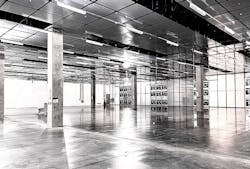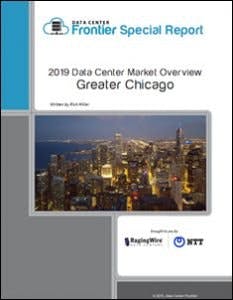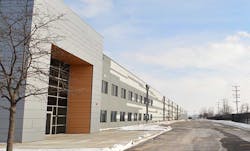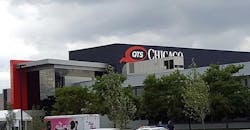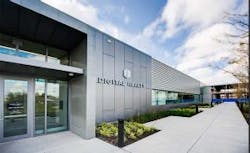New Data Center Players Enter the Greater Chicago Market
The Greater Chicago Data Center Market is getting two new players in less than a week, as Aligned and Skybox Datacenters have opened new facilities in the Western suburbs near O’Hare Airport. The new entrants highlight the strong rebound in the Chicago market, which has gained momentum following the passage of new tax incentives in 2019.
Chicago is one of the nation’s premier markets for data center services, occupying a central place in America’s geography and mission-critical infrastructure. The Windy City is also a major hub for Internet and financial infrastructure, with active communities of data-center users and service providers.
Download the new Special Report covering the Chicago Data Center Market.
Chicago is America’s third-largest city, with an active business market with nearly 40 Fortune 500 companies headquartered in the metro area. After several years of steady but unspectacular leasing, interest in the Chicago data center market has rebounded in the last year, sparked by economic incentives and new projects in both the Downtown and Suburban Chicago areas.
Chicago is distinctive in that it sees demand for data-center space from a wide range of industries. It is home to major trading exchanges for stocks, commodities and options, making the city a hotbed of activity for the financial services industry.
Chicago Market’s Active Building Phase
The Chicago region has become a favored location for hosting, colocation and cloud computing companies. Chicago sees strong demand from the enterprise sector as well, both for primary data centers and as backup/disaster recovery facilities.
And according to CBRE hyperscale data center activity has started to rise as users and colocation providers take advantage of state tax incentives.
According to JLL, commercial real-estate services company, total Chicago data-center inventory comes to 5.07 million square feet (SF) and 631.6 megawatts (MW). And there is plenty of space not spoken for for new entries to the market.
There is a total of 426, 500 SF and 62.0 MW of vacant space, as well as lots of new construction in the sector underway, with data-center construction reaching 190,000 SF and 18.5 MW.
Chicago saw significant development activity in 2021, delivering around 15 MW of new supply in the first half of the year, CBRE reported. New construction in Chicago was driven largely by growing hyperscale demand of multi-tenant data center facilities.
Here are some examples of this new construction:
- Aligned Energy has just opened its ORD-01 data center in Northlake and commenced construction on ORD-02, a 228,768 SF building scheduled to support between 36 and 52 megawatts of capacity.
- Skybox Datacenters and Prologis have just opened a 30-megawatt, 189,000 square foot project in Elk Grove Village the leading data center hub in the Suburban Chicago market.
- Prime Data Centers will invest $1 billion to create a three-building, 750,000 square foot data center campus in Elk Grove Village.
- NTT Global Data Centers Americas is building out the second building on their Itasca facility, with completion scheduled for this coming fall.
The exterior of the Skybox Powered by Prologis data center in Elk Grove Village, Ill. in Suburban Chicago, which opens this week. (Photo: Skybox Datacenters)
Why Chicago?
New players continue to enter the Chicago market, while incumbent providers are adding space to accommodate future demand. Element Critical and SBA Communications have recently entered the market through smaller deals.
New technologies are driving strong demand in the Chicago area for data-center space and network capacity. Chief among these trends is the gradual shift of IT capacity from enterprise data centers to web-scale cloud computing platforms, which is already driving historic demand from cloud builders like Amazon, Microsoft and Google.
The region’s competitive position got a boost when Illinois approved a new tax incentive plan in 2019 aimed at jump-starting data center development in the state. Data-center projects receive exemptions from state and local sales taxes on data center equipment for 10 years, if they invest a minimum of $250 million in the facility and create 20 high-paid full-time jobs. New development in low-income areas will also receive a 20% income tax break.
Chicago is among the regions positioned to benefit in coming years as new technologies drive massive demand for data center space and network capacity.
The QTS Chicago data center . (Photo: Rich Miller)
Another potential incentive for data-center providers is to leverage the Illinois Economic Development for a Growing Economy Tax Credit Program (EDGE). For example, in 2014, QTS Data Centers made a deal to buy the former Chicago Sun-Times newspaper printing facility and convert it into a data center. The deal was endorsed by the Chicago Committee on Economic, Capital and Technology Development and granted a property tax break to reduce the property’s assessed value for 12 years—and save QTS $11.4 million over that period.
Similar to other states with programs to revitalize economically depressed areas, Illinois’ Enterprise Zone Act enables qualifying businesses to receive a sales tax exception.
The city of Chicago’s Data Center Express program also helps to identify areas in Chicago proper that are ripe for investment and redevelopment, like the city’s South Side.
New projects that will invest at least $250 million and create 20 full-time high-paying jobs will receive exemptions on state and local sales taxes on equipment purchases for 10 years.
The Chicago market is attractive to data center users for several reasons:
- Favorable business climate
- Competitive colocation/cloud environment
- Relatively low power cost
- Low risk of natural disasters
Regional Data Center Trends to Watch
DOWNTOWN CHICAGO
Chicago data center’s are split into two market opportunities — downtown and suburban. Downtown Chicago is an urban market with excellent connectivity and a limited amount of space.
Downtown data center real estate is focused on “carrier hotels” that lease space to IT and telecom companies, many seeking proximity to the city’s financial trading platforms. The Digital Realty facility at 350 East Cermak has emerged as Chicago’s primary data hub, housing dozens of service providers.
Downtown Chicago has primarily been a retail colocation market, offering connectivity and interconnection services but few large physical footprints. For many years, space at 350 East Cermak and other downtown hubs has been in short supply, with limited new inventory coming online.
That started to change with the 2017 opening of a new QTS data center in the former Chicago Sun-Times printing plant on S. Ashland Avenue. Additional inventory came online in 2020, with CoreSite’s new 18 MW purpose-built data center.
SUBURBAN CHICAGO
Suburban Chicago is home to a thriving market for wholesale providers and single-tenant data centers. Chicago’s suburbs offer the larger footprints that are difficult to find downtown.
Leasing in the suburban market was initially slow, but soon accelerated with large deals for space by service providers like Rackspace and Deft, formerly known as ServerCentral. Enterprise deals soon followed, notably at the Ascent Corp., site in Northlake. Digital Realty has also made the move to the suburbs with a large campus in Franklin Park.
CyrusOne now operates a data center in Aurora, with the CME financial exchange as a major tenant, while NTT Global Data Centers (Itasca) implemented large new projects in Suburban Chicago.
In recent years, the Suburban Chicago market has seen active development in the area surrounding O’Hare Airport, especially Elk Grove Village and Franklin Park. Long-range capacity plans for the area call for construction of another new ComEd substation in north Elk Grove Village.
Supply trends
Available supply increased in the first half of 2021 with newly commissioned capacity from T5, NTT/RagingWire, Digital Crossroads, and Element Critical. Additional projects were announced by Aligned, EdgeConnex, Stream and Skybox,.
Chicago’s active community of cloud providers also provides a “future-proofing” effect, increasing the likelihood that demand for space will remain strong even as corporate IT users shift workloads from on-premises data centers to cloud platforms.
In 2018 and 2019 most of the wholesale deals in Chicago were in the 500,000 KW to 3 MW range. During that period, the market didn’t see any of the massive hyperscale deals from previous years, which included a 14.5 MW lease in 2017 and a 30 MW lease in 2016.
There are signs that Illinois’ passage of tax incentives is generating new interest in the Greater Chicago market. Providers in the region report an increase in inquiries about space, a trend illustrated by recent spikes in search traffic on datacenterHawk.
There was tepid leasing activity in the first half of 2021 among enterprise users. However, it was backed up by existing customer expansion, inbound edge requirements and smaller hyperscale transactions across the market, according to JLL.
The Digital Realty data center campus in Franklin Park in Suburban Chicago. (Image: Digital Realty)
Demand trends
Users have picked up activity on both the enterprise and hyperscale sides. Vacancy rates were down as a result of an increase in demand from hyperscalers. The market is also seeing pre-leasing activity trend upwards.
Of the 527.6 MW of data-center space under construction midway through 2021 in primary markets, 317 MW or 60% has been pre-leased. That includes 17.1 MW in Chicago, according to CBRE.
Demand in the downtown Chicago market will continue to be driven by connectivity, inter-connection and access to the city’s financial exchanges and business customers in the central business district, the 2021 CBRE report explains.
The marquee facility in Downtown Chicago is 350 East Cermak, a massive 1.1 million SF carrier hotel operated by Digital Realty. Data centers inside 350 East Cermak often market themselves as operating inside one of the world’s largest carrier hotels.
The Chicago market has a healthy balance of data-center requirements coming from both outside and inside the market. Colocation users find the Chicago market attractive because of its central location and proximity to large, corporate businesses.
The growth of cloud computing has had significant benefits for the Chicago market. Some hyperscale providers have even built large campuses in rural areas around the city. Latency and proximity to customers remain important priorities for online service platforms, making Chicago attractive for its geography and critical mass of customers.
According to the JLL report, the demand and the outlook for the future Chicago market will be defined by increased competition by spec developers and land banking, as well as rate compression and submarket specific requirements.
Business Environment
An abundance of fiber providers and several Internet exchanges make Chicago a hub for content delivery services to a large portion of the American Midwest. On July 1, 2015, local Chicago politicians approved levying a 9% tax on local consumers of subscription cloud services such as Netflix, Spotify and Xbox Live. Because enforcement of this so-called “Netflix Tax” on consumers will also add a compliance burden on the companies that deliver the services, data center providers should be aware of these potential added costs.
The Illinois General Assembly passed legislation in 1997 that deregulated the state’s electricity markets. The law separated the business of generating and selling power from the business of transmitting and distributing it. Commonwealth Edison (ComEd) is now a subsidiary of Chicago-based Exelon Corp., and sells and distributes power.
Downtown Chicago, as seen from the 94th floor of the John Hancock Center. The city is one of the nation’s major data center markets. (Photo: Rich Miller)
The city of Chicago is in discussions about renewing its franchise agreement with ComEd, the main energy provider, for the first time since 1992. The renewal may improve the reliability of the electric grid and environmental impact of electricity, as city officials and ComEd are working together to align the agreement with clean-energy objectives. Chicago businesses may also see higher power pricing going forward.
The Chicago market has a low risk for natural disasters. Hurricanes are non-existent, and it is rare that seasonal storms result in flood or tornado damage. The United States Geological Survey (USGS) notes that while the New Madrid fault line runs through southern Illinois, the small earthquakes caused by it have limited effect on Chicago. There have only been eight earthquakes in northern Illinois registered by the USGS in over a 100 years, but none have caused any significant damage to the Chicago area.
Chicago’s high property taxes can be a deterrent for new construction and data-center providers. On top of the city’s relatively high property taxes, Chicago proper enacted a 10.25% sales tax in October 2015. The new rate is one of the highest in the United States and higher than 99.6% of other locales in Illinois. This is a key reason many data centers set up in the city’s western suburbs where the sales tax rates can be a quarter of a percentage point lower— a significant savings when considering the scale of investment required for a data center.
And as aforementioned, tax incentives like the EDGE program as well as the Illinois’ Enterprise Zone and the city of Chicago’s Data Center Express program means big opportunities to save for new colo providers entering the market, potentially making high property taxes a moot point.
Providers Serving Chicago
As for the biggest players in the Chicago Data Center Market, these include new and seasoned entries into the market, spanning cloud providers, data center leaders and colocation giants.
Below is an overview of major data center and colocation providers in the Chicago data center market:
The below companies have at least one data center in Chicago:
- 360TCS
- 365 Data Centers
- Aligned Energy
- Ascent Data Centers
- DataBank
- Digital Realty
- EdgeConneX
- Element Critical
- Evoque Data Centers
- INAP
- Iron Mountain
- Digital Crossroads Data Centers
- Lincoln Rackhouse
- Netrality Properties
- NTT Global Data Centers Americas
- QTS Data Centers
- SBAEdge
- ServerFarm
- Stream Data Centers
- Skybox
- TierPoint
- T5
Explore the Chicago colocation market further through Data Center Frontier’s special report series and ongoing coverage of the growing colocation industry in the top data center market in the country, which can be found below.
About the Author

